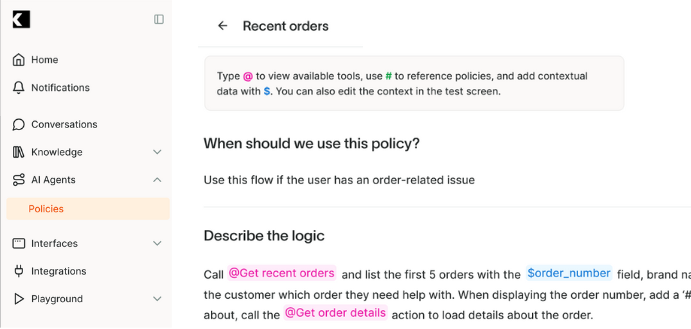Ingredients
The systems used by this policy include Shopify, Zendesk, and Kodif. These platforms work in tandem to streamline the customer support process, particularly in handling refund requests efficiently.
What are AI Policies?

At Kodif, we’re excited to announce the launch of Policies—a powerful, dynamic solution designed to revolutionize the way CX managers handle customer support. Unlike traditional flows, which are rigid and complex, Policies empower non-technical users to create and manage customer interactions with ease. Written in natural language, Policies make it simple to define and refine customer experiences without needing to rely on complicated flowcharts or scripting. This approach is not only user-friendly but also self-serve, enabling CX teams to quickly translate existing Standard Operating Procedures (SOPs) into automation, saving valuable time and resources.
The flexibility of Kodif Policies ensures that businesses can offer personalized, context-driven support while continuously improving customer experiences. With Policies, you can experiment with different strategies to optimize outcomes such as CSAT, revenue, and retention—all without the need to rebuild complex workflows. Whether it’s automating routine interactions or testing new approaches for high-stakes scenarios, Policies provide a scalable, adaptable solution that aligns with your business goals. While flows still have their place in sensitive, high-risk situations, Policies offer an agile alternative that helps businesses innovate faster and deliver exceptional, tailored experiences at scale.
“Refund order” ticket type explained
In customer support, a “Refund order” ticket type refers to a request initiated by a customer who wishes to return a purchased item and receive their money back. This type of ticket is crucial in maintaining customer satisfaction, as it involves refunding the payment made by the customer for a product that they no longer want or need, or that may have been defective or incorrect. Efficient handling of refund requests can significantly enhance customer trust and loyalty, as it demonstrates a commitment to customer satisfaction and a seamless return process.
Which Platforms does this AI policy work on?
This AI policy is designed to work seamlessly with Shopify, Zendesk, and Kodif. Additionally, Kodif integrates with all other major platforms, ensuring a versatile and comprehensive solution for various e-commerce and customer service environments.
When should I use this policy?
This policy should be used when customers request a refund for their orders. Utilizing this policy helps streamline the refund process, ensuring that customer requests are handled quickly and efficiently while maintaining clear communication throughout the transaction.
Policy logic
To implement this policy, follow these steps:
-
Ask for the user’s email address
-
Use @get_shopify_account_details tool to check if the user with that email exists in Shopify.
- If the email address was not found, ask for a valid email address.
-
If the email address is still not found, route it to an agent for further investigation.
-
Display Recent Orders
-
Use @get_shopify_orders to retrieve the user’s recent orders.
- Display the list of recent orders and ask the user which specific order they would like to inquire about.
-
If the order was not found, route to an agent for further investigation.
-
Check Refund Eligibility
-
Use @shopify_order_details to check the status and eligibility of the selected order for a refund.
- If the order is eligible for a refund, verify the return and refund conditions (e.g., within the return window, product condition, etc.).
-
If the order is not eligible, inform the user that the order is outside the refund window or does not meet the conditions for a refund, and provide alternative options (e.g., store credit, exchange).
-
Initiate Refund Process
-
If the order meets the refund criteria, ask the user to confirm their request for a refund.
- Use @shopify_issue_refund to initiate the refund process in Shopify.
-
Inform the user that the refund process has started, and provide them with an estimated timeline for when the funds will be credited back to their payment method (typically within 3-5 business days).
-
Notify the User
-
Inform the user in the chat that their refund has been successfully initiated.
-
Shopify will send a confirmation email to the user regarding the refund status and details.
-
Refund Follow-Up
-
Advise the user to check their bank or payment provider for any updates on the refund processing timeline.
-
If the user has questions regarding the refund status after the estimated time frame, encourage them to reach out for further assistance.
-
Escalation
-
If the refund cannot be processed or if there are any issues, route the request to an agent or create a ticket for further investigation.
- If the user prefers a store credit or exchange instead of a refund, offer these options and use the appropriate tools to process them.
Example policy
To effectively implement the refund process, you can use the same logic and steps outlined above by utilizing the appropriate tools and commands in Shopify and Zendesk. This ensures a streamlined experience for both the customer and the support team, minimizing the time and effort required to process refunds while maintaining high customer satisfaction levels.


